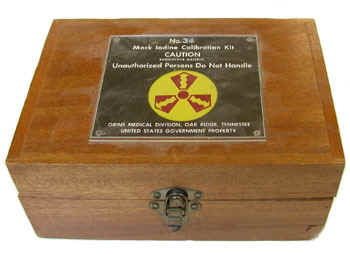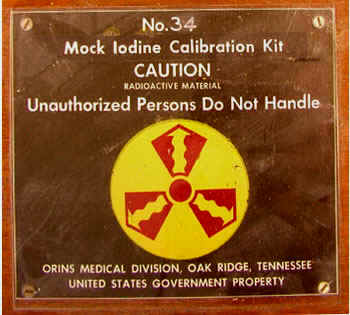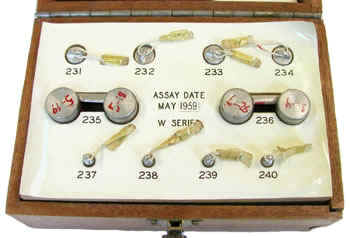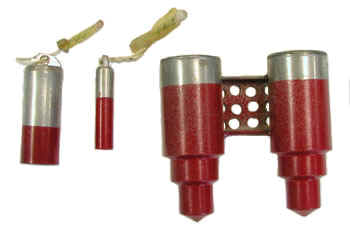ORINS Mock Iodine Calibration Kit (1958-1959)
In 1958 Marshall Brucer, Chairman of the Medical Division of the Oak Ridge Institute of Nuclear Studies (ORINS), was granted a patent for mock iodine. The mock iodine calibration kit shown here was donated by Brucer. It bears two dates, 1958 and 1959. The first such kits were produced around 1955 or so.


Size: 6" x 9" x 4"
In the 1950s iodine-131 was widely used to evaluate thyroid function. The short, half life of I-131, eight days, was good in some respects, but it meant that I-131 was not suitable for routine calibrations of the equipment used to measure uptake (NaI and GM detectors). For this reason, Marshall Brucer developed a substitute he called "mock iodine," a mixture of barium-133 and cesium-137. Quoting Brucer: "This mixture is made in order to produce a calibration source that has a useful life of about 10 to 15 years, but still gives a [gamma ray] spectrum that is similar to that of iodine 131. The cesium 137 in the mock iodine is used to match the high-energy peak of iodine 131. The high energy peak of iodine 131 is at about 640 kev and there is a minor peak at 722. There is no such minor peak in cesium 137. The primary energy of cesium 137 is at 660 kev. Therefore, the two high energy peaks are not identical; it would take fairly well adjusted and carefully stabilized pulse-height spectrometry to detect the differences of these two peaks. In most thyroid uptake measuring equipment the difference between these two peaks cannot be detected. The barium 133 is used in mock iodine to match the 360 kev peak in iodine 131. However, there is less of the 360 keV and more of the 280 kev in mock iodine than there is in iodine 131. Any good narrow band spectrometry could detect the difference in the 280 kev range. In most integral counting systems the deficiency of 360 kev and the excess of 280 kev energies cancel each other."


This particular kit has two mock thyroids (one is seen on the far right of the photograph above right). These kits usually employed 5 microcuries in one "thyroid" and 50 microcuries in the other. There are also four mock "test tubes" (one is seen on the left side of the photo) and four mock "capsules" (one is shown in the middle of the photo). Unlike this example, the standard kits apparently contained five tubes and five capsules. The activities in the tubes ranged from 0.01 to 50 microcuries while the activities in the capsules ranged from 0.001 to 10 microcuries. They were designed to be employed with the ORINS thyroid uptake phantom.
References
- Marshall Brucer. Radioiodine Uptake Measurement. Apartado del Acta Radiologica Interamericana. Volume VII, No. 3-4, 1957.
- Marshall Brucer. Thyroid Radioiodine Uptake Measurement. A Standard System for Universal Intercalibration. ORINS-19. June 1959.
